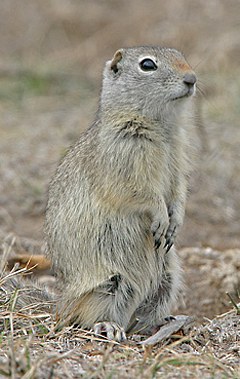The Scottish naturalist Sir John Richardson (1787-1865) published the first official scientific description in 1820, giving it the binomial, Spermophilus (sper-mo-fill-us, “seed lover”) richardsonii (richard-SO-nee-eye, “of Richardson”). Lewis had written his brief account of the new species on 25 February 1806:
the small grey squirrel common to every part of the rocky mountain which is timbered, difirs from the dark brown squirrel[1]Tamiasciurus douglasii, commonly known as Douglas’s squirrel, or chickaree. . . . only in its colour. it’s back, neck, sides, head, tail and outer side of the legs are of a brown lead coloured grey; the tail has a slight touch of the fox colour near the extremity of some of the hairs. the throat, breast, belly, and inner parts of the legs are of the colour of tanners ooze[2]Tanner’s ooze, properly owster (Webster, Compendious Dictionary, 1806) is a dye concocted of oak bark and water in which animal hides are soaked to give them an even shade of brown. and have a narrow stripe of black commencing just behind each sholder and exten[d]ing longitudinaly for about 3 inches betwen the colours of the side and belley. their habids are also the same of the dark brown squirrel of this neighbourhood and like them are extreemly nimble and active.
This ground squirrel was, Lewis added, “found in every part of the country, as well the praries [and] woodlands, and is one of the few animals which we have seen in every part of our voyage. it differs not at all from those of the U’ States.”
Its overall length, including a two- to three-inch tail, is only 11 or 12 inches. It thrives on roots, leaves, and seeds of native grasses and forbs, as well as those of many domestic garden plants. Its eyes are set high in its skull to enable it to scan the sky for predators such as hawks before emerging from its burrow.[3]drian Forsyth, Mammals of North America: Temperate and Arctic Regions (Buffalo, New York: Firefly Books, 1999), 102-3.
Its erect pose at the portals of its extensive burrows, prompted by some potential threat, has earned it the nickname “picket pin,” from the iron peg driven deep into the ground to which horses—especially the mares—are sometimes tied at night to prevent them from straying.
Notes
| ↑1 | Tamiasciurus douglasii, commonly known as Douglas’s squirrel, or chickaree. |
|---|---|
| ↑2 | Tanner’s ooze, properly owster (Webster, Compendious Dictionary, 1806) is a dye concocted of oak bark and water in which animal hides are soaked to give them an even shade of brown. |
| ↑3 | drian Forsyth, Mammals of North America: Temperate and Arctic Regions (Buffalo, New York: Firefly Books, 1999), 102-3. |

